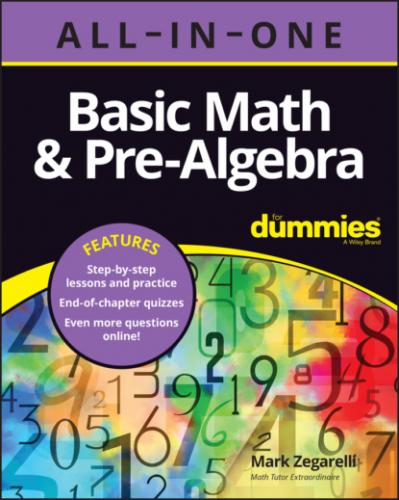Remember that, in any true statement, the large open mouth of the symbol is on the side of the greater amount, and the small point is on the side of the lesser amount.
Less than or equal to (≤) and greater than or equal to (≥)
The symbol ≤ means less than or equal to. For example, the following statements are true:
Similarly, the symbol ≥ means greater than or equal to. For example,
Approximately equals (≈)
In Chapter 3, I show you how rounding numbers makes large numbers easier to work with. In that chapter, I also introduce ≈, which means approximately equals.
For example,
You can also use ≈ when you estimate the answer to a problem:
A. <. Because
Q. Place the correct symbol (=, >, or <) in the blank:
A. >. Because
Q. Sam worked 7 hours for his parents at $8 an hour, and his parents paid him with a $50 bill. Use the symbol ≠ to point out why Sam was upset.
A.
He was upset because his parents didn’t pay him the correct amount:
Q. Find an approximate solution to
A. 8,000,000. The two numbers are both in the millions, so you can use ≈ to round them to the nearest million:
Now it’s easy to add
15
(a)
(b)
(c)
(d)
16 Change the ≠ signs to either > or <:
(a)
(b)
(c)
(d)
17 Tim’s boss paid him for 40 hours of work last week. Tim accounted for his time by saying that he spent 19 hours with clients, 11 hours driving, and 7 hours doing paperwork. Use ≠ to show why Tim’s boss was unhappy with Tim’s work.
18 Find an approximate solution to 10,002 − 6,007.
Moving Beyond the Big Four: Exponents and Square Roots
In this section, I introduce you to three new operations that you need as you move on with math: exponents, square roots, and absolute value. As with the Big Four operations, these three operations tweak numbers in various ways.
To tell the truth, these three operations have fewer everyday applications than the Big Four. But you’ll be seeing a lot more of them as you progress in your study of math. Fortunately, they aren’t difficult, so this is a good time to become familiar with them.
Understanding exponents
Exponents (also called powers) are shorthand for repeated multiplication. For example,
In this example, 2 is the base number and 3 is the exponent. You can read
Here’s another example:
That works out like this:
This time, 10 is the
